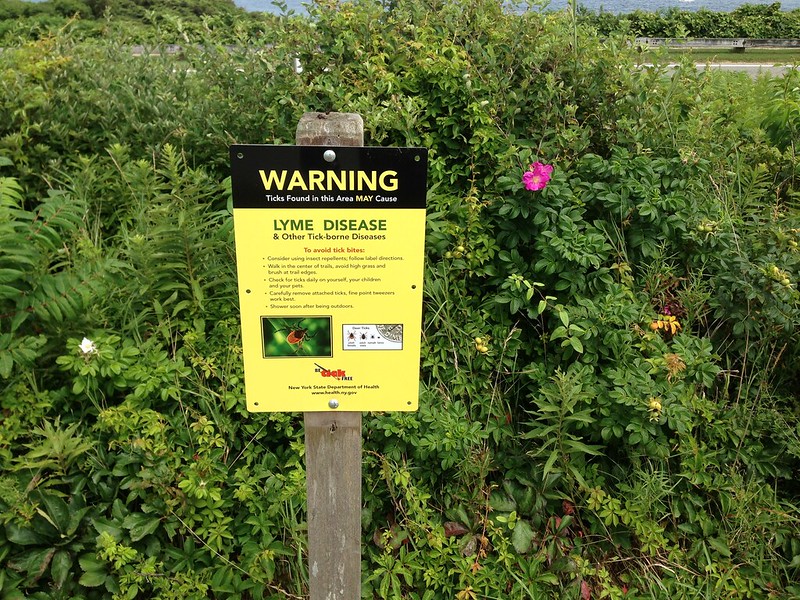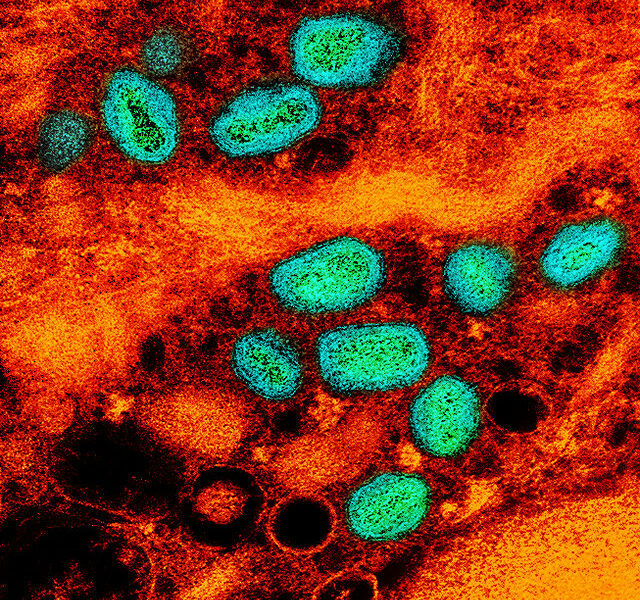By Amelia Thyen
Photo courtesy of Neil R; CC-BY-NC.
In the United States (US), Lyme disease is spread through the bite of a deer tick infected with Borrelia burgdorferi or Borrelia mayonii bacteria.1 Deer ticks are found often in wooded areas, and a majority of cases of Lyme disease in the US occur in northeastern states, upper midwestern states, and states along the Pacific Coast.2 Symptoms of Lyme disease often start with fever, headache, and nausea, and if left untreated can spread to infect the joints, the heart, or the nervous system. There are diagnostic tests available, but they may not always be accurate and can take days to return results in some cases. Instead, a large red circular rash around the area of the tick bite called erythema migrans can also be the basis of diagnosis on its own.3 Once this rash is detected, it is important to start antibiotics quickly to ensure a faster and more complete recovery.3
The CDC reports that Lyme disease is the most common vector-borne disease in the US; approximately 30,000 cases are reported through the Nationally Notifiable Diseases Surveillance System (NNDSS) per year.2 However, the exact number of cases that the US experiences each year is unclear. The CDC estimates that the true number of infections is much higher than 30,000, due to the passive surveillance methods used by the NNDSS that may miss cases as well as healthcare providers’ underreporting.9 A recent publication has given an updated estimate of the burden of disease in the US, and the results are startling.
This report, published by the nonprofit organization called FAIR health, used claims data over the past 15 years to estimate a case count of Lyme disease among the population.4 Researchers found that from 2007 to 2021, there was a 357% increase in Lyme disease diagnosis insurance claims among rural patients, and a 65% increase in Lyme disease diagnosis insurance claims among urban patients. Overall, the report suggested that approximately 476,000 cases of Lyme disease were diagnosed and treated among people in the United States each year, which is a much higher estimate than previous CDC counts.4 In 2021, the states with the greatest proportion of Lyme disease diagnoses according to the claims data were New Jersey, Vermont, Maine, Rhode Island, and Connecticut.4 With these updated case counts, it is clear that past estimates are underreported and there is a need for increased attention to be turned toward the rising incidence.
Powassen virus is another disease that is spread through ticks; however it is much more rare than Lyme disease. The US has seen about 25 cases of Powassen virus every year since 2015.5 Similar to Lyme disease, the CDC estimates that Powassen case incidence has increased in the past decade, and that cases are most common in northeastern and upper midwestern US states.6 Recently, there have been reports of fatal Powassan virus cases across the East Coast.
Earlier this year, deaths due to Powassen virus were reported in Maine and Connecticut.5,7 A toddler in Pennsylvania was recently hospitalized with Powassan virus after experiencing fever, fatigue, and headache two weeks after being bitten by a tick while swimming in his neighbor’s pool.8 Similarly to Lyme disease, Powassan virus is likely vastly underreported, and updated case counts are needed to understand the true disease burden.
While antibiotics are available to treat Lyme disease, there are no available medications to treat Powassan virus.2,6 Unlike Lyme disease, symptoms of Powassan virus are much more delayed. Symptoms often start around one week to one month after a tick bite, and lead to fever, headache, and altered mental status5. Most people infected with Powassen virus are asymptomatic, but there are rare cases when more serious symptoms such as encephalitis and meningitis can occur.5 It is estimated that about 1 in 10 cases with severe symptoms are fatal.5
Because cases of tick-borne illness are on the rise in the US, it is important to remind everyone about prevention methods. The best way to prevent Lyme and Powassan disease is to prevent tick bites. Ticks are most active in the summer months, when people are more likely to be spending time outdoors. It is important to check your clothing, hair, and body for ticks after spending time outdoors, and properly remove any ticks that you find. Showering within two hours of being outdoors can reduce the risk of getting Lyme and Powassan disease, and provides an opportunity to check yourself for ticks.2 It is also important for parents to check for ticks on their children, and for pet owners to check for ticks on their pets.
As cases of tick borne illnesses increase, and the geographic location where the ticks are located expands due to climate change, it is important that public health officials remind all residents of prevention and treatment methods.
References
- https://www.mayoclinic.org/diseases-conditions/lyme-disease/symptoms-causes/syc-20374651
- https://www.cdc.gov/lyme/datasurveillance/recent-surveillance-data.html
- https://www.webmd.com/skin-problems-and-treatments/what-to-know-erythema-migrans#:~:text=Erythema%20migrans%20is%20a%20rash,be%20warm%20to%20the%20touch.
- https://www.ajmc.com/view/contributor-private-claims-data-reveal-marked-increase-in-lyme-disease-diagnoses
- https://www.maine.gov/tools/whatsnew/index.php?topic=Portal+News&id=7360066&v=article-2017
- https://www.cdc.gov/powassan/symptoms.html
- https://www.nbcnews.com/health/health-news/connecticut-woman-dies-tick-borne-powassan-virus-rcna32760
- https://people.com/health/3-year-old-pennsylvania-boy-contracts-rare-powassan-virus-from-tick-bite-in-pool/
- https://www.cdc.gov/lyme/stats/humancases.html


